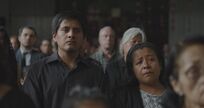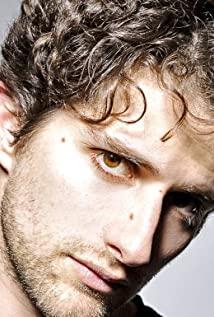The New Order by the Mexican new-generation director Michelle Frank is undoubtedly the most talked about film at this autumn film festival. The film is short and concise, less than ninety minutes. The various "visual spectacles" that are concealed sharply present today's troubled and extremely divided society. The class divide, the corruption of the ruling class, the rich living in the bubble, the spreading demonstrations and their resulting violence are the "main theme of the times". But the director is not satisfied with this. On top of this, the film's vision points to beyond the riots and to the most likely end point of all this chaos - a "new order" that advocates more force and totalitarianism. After the conflict, instead of the dawn of dawn, everyone fell into a deeper whirlpool. And compared with the original ruler, the new regime is more ruthless, more intelligent, more cruel and more rogue.
The film opens with a focus on the wealthy area of Mexico City. The Novello family's daughter is married. In a large villa, guests are dressed in fancy clothes, staggered, and enjoy a beautiful life under the pleasant sunlight. They did not notice, or deliberately ignored, the riots that were taking place in the neighborhoods not far from the heavily guarded walls. The hostess shuttled in and out of the house, and inadvertently, the green liquid from the tap in the bedroom made her uneasy. She gradually began to check every place where the water came out of the mansion, and the camera followed her footsteps, taking us to a further sense of the intoxication of high society.
However, the strange thing is not only this one. The witnesses were late to the scene, and several guests were attacked on their way there. They were covered in green paint sprayed by the protesters. The servants who prepared meals in the kitchen pointed at each other strangely. An uninvited guest, Rolando, who has been away from the host's home for eight years. In order to pay his wife an expensive operation fee, he had to turn to his former employer.
The first half hour of the film vividly shows us what a "rich man's weekend" looks like. It is very likely that a business will be negotiated between cups and cups. Men lead their wives and daughters around like women display jewelry. There may be blatant jokes behind the show, etiquette and proportions, and the exchange of power and money is naked enough to put on the table, not only the generous gift in the envelope, but also the marriage itself. At the same time, the audience who mastered the "omniscient perspective" began to smell the tension a little bit. A few simple questions and answers by Rolando and the hostess at the door of the house were vaguely chilling, which implied that even through friendly negotiations between the rich and the poor, it is difficult to Reconcile deep contradictions. In the end, the bride Marianne was also involved, thinking of her old love, and at the same time holding the mentality of trying to cut herself off from her snobbish mother and brother. She resolutely chose the most important day in her life, left the wedding banquet, and went to Rolando's house to honor herself. of kindness.
Back at the house, the danger looms as scheduled. The dark-skinned aborigines jumped over the wall, and they approached the panic-stricken guests with murderous aura, and the expected burglary began. Not only the foreign intruders, but also the entourage of the rich people, drivers and servants also joined the looting team. Hold the hostess' head to open the safe, drive the guests to the corner, and threaten to order them to transfer money and hand over their belongings one by one. As the gunshots rang out, the proletarians enjoyed the joy of the reversal of status, the thrill of power and coercion, and we watched all this and began to think about which side of them we stood on.
But that's not the whole story, or just the beginning of the nightmare. The film started a new chapter in the next hour, and the director's "blackened" face gradually began to be revealed. It was thought that the bride, who left in time, was lucky to escape the disaster, and the family, who was portrayed as the opposite of her kindness, was "due for retribution", but the truth is just the opposite. After a few freeze-frame transitions, sweeping through the empty streets, corpses everywhere, and black smoke that has not yet been extinguished, we see that the army quickly takes over the situation overnight, and the "rioters" who are easily recognizable by their skin color are This is a somewhat unbelievable complete exit, replaced by a more disciplined force of government. Martial law, interrogation, curfew, before the audience digested the real motivation behind the riot, and observed the reactions of all parties, the worship of order and the double control of personal freedom overwhelmed the instinctive fear. Marianne, who was trapped in a poor area, was quickly taken away by the military police, but instead of being escorted home, she was thrown into another "human purgatory".
I don't need too many words to describe what happened next, and it's not hard to imagine what happens when the elements of tough power, easy money, human animal nature, and imprisoned beauty are juxtaposed. But when we actually witnessed this tragedy on the screen, we still couldn't help but tremble. In the prison with Marianne are the family members of wealthy people who were inexplicably arrested in the riots like her. These people have become the sacrifices of the "New Order", and they have also become tools for the bottom military and police to "earn extra money" and vent their anger. The revelry and revenge of the previous mob invasion of the mansion, the unprovoked evil unleashed in the act of expressing their demands, extends seamlessly here. The abuse of children of wealthy families in prison is a more brutal continuation of street violence. The message the director wanted to send couldn't be clearer: when the state apparatus is empowered to quell atrocities, it's often the beginning of another catastrophe. More terrible than the imbalance of power is the abuse of power.
On the whole, the second part of the film is somewhat "godgy", with its almost paranoid portrayal of violence and dehumanization, sexual abuse scenes with more bad taste than reality criticism, and seemingly effortless killing of civilians. , and the complete breakdown of the social contract, would make any discussion of the legitimacy of this riot and the "new order" that followed would be rendered moot. In front of the vivid issues reflected in the film, at the end you will realize that because "there are too many dead people", there is no way to discuss the deeper social and value aspects. The main characters in the plot left a lot of impressions, but most of them did not leave the audience with even a slightly more specific point of view or idea. The indigenous people who initially provoked the incident and the military and police who later took over the situation were in a state of "aphasia" throughout the whole process.
In the danger of a "dystopian allegory" becoming a fantastical "visual feast" or even a horror film, we can't yet ignore the message and emotional perspective of the film. Looking back, the main line of the film is still dominated by the rich class, depicting their deep fear as "good people who abide by their duties" in the face of class turmoil. If the burglary expresses what they see as the direct conflict and threat of social change to their own interests, then the tragedy that happened to Marianne (including the final outcome) represents the rich people’s subconscious perception of the foundation of a post-change society. Awareness and exclusion. Because in their view, whether it is a mob that rises up, or a military regime that continues to perpetrate violence by maintaining order, there is essentially no difference, both are extremely barbaric animals, and neither is the way out for civilization. The film "New Order" skillfully collages the two motifs of class movement and totalitarian society, trying to use the horror of the latter to discuss the ineffectiveness of the former. It was successful in the sense of caution, but in the final analysis it was still a "one-sided word" from the perspective of the wealthy class. The film not only eschews the perspective of the "rebel" in social movements, but also greatly simplifies and over-exaggerates the "demon" attributes of those in power in a totalitarian society. This kind of storytelling doesn't put the cart before the horse, but it is at least not 100% candid in explaining why "the rich are so innocent and so hateful."
Some people say "The New Order" is a sequel to "Joker" about what awaits us after the "mob spree", but at the same time, the film seems to go a bit on the point of depicting "unprovoked evil" Far. It is undeniable that this work is very forward-looking, and some of its bridges are even very close to many events happening in 2020 at the moment. However, a bold "Fable of the End Times" should not become a "narcotic" in front of reality, nor should the "nihilistic" atmosphere in the second half of the film be the only possibility to define the future. The transformation of destruction into a way to change the status quo within the current ability is more worthy of careful consideration.
View more about New Order reviews











